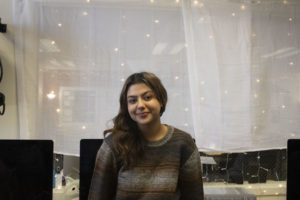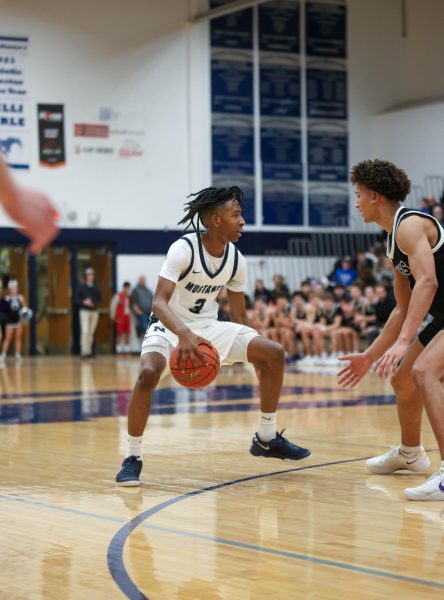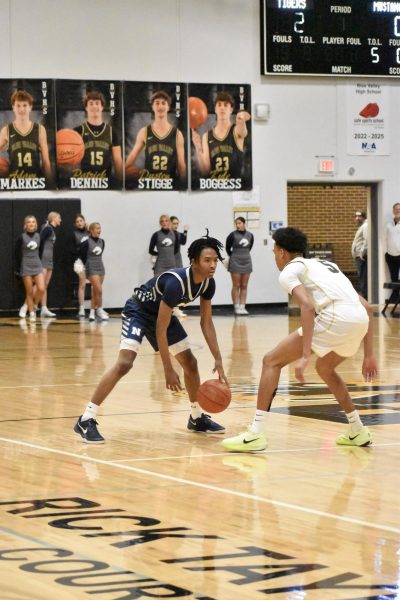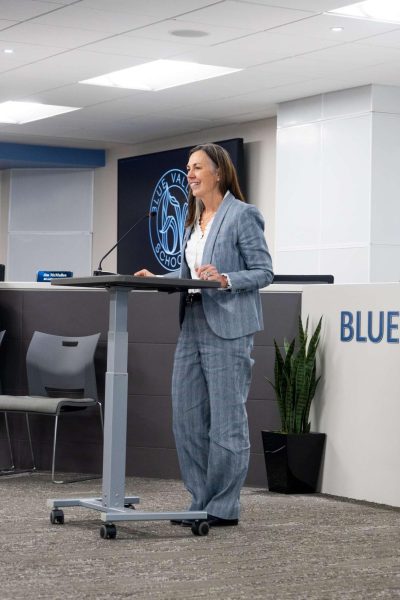A Kansan Lense: Black History in Kansas Schools
As Black History Month comes to an end, conversations of race and inequality in the local landscape continue.
Kansas is not unique in its long history of racial segregation. From the discriminatory Troost divide to redlining practices ingrained in housing communities, a past of apartheid and inequality haunts the Kansas City metropolitan area. How does its ghost affect students today? As a first year participant of Race Project KC, I sat down with two of the organization’s BVN chapter leaders, seniors Sydnie Sykes and Ephren Taylor, to discuss how the state’s history of discrimination relates to its schools’ environments today. Our conversation has been condensed and edited for length and clarity.
How long have you been involved in Race Project KC and BVN Coalition?
Sykes: I’ve been in the coalition club since Jan. 2019, which was the second semester of my freshman year, and I’ve been involved in Race Project KC for around that same time.
Taylor: Yeah, I did all the same things. [Race Project KC] had a field trip, which we took. It was a dividing lines tour; basically, we toured the Kansas City area, and we got to see all of segregation and redlining policies that kept Black people from obtaining houses and creates the sort of inequity that we see today.
What are the goals of these respective groups? How are they different?
Sykes: So Race Project KC is a social justice initiative, aimed at erasing the lines between students of different socioeconomic and cultural backgrounds in the Kansas City area. So that’s kind of uniting kids that live in the suburbs, like we do in Overland Park, or rural areas, or urban areas, like Wyandotte or Jackson County. So it’s aimed at teaching students how their history was formed, how systemic injustices, systemic segregation, like Jim Crow laws, formed their neighborhoods, and to this day, why one neighborhood looks different than the other.
Taylor: I would describe the BVN Coalition as the facilitation club for Race Project KC, that’s kind of how I see it. It kind of brings students together for us to then do projects like Race Project KC. We may not always do that, but generally, that’s what I’d say it’s for.
Sykes: BVN Coalition is just – what a coalition is bringing people together to go towards a common goal, which in our case, is Race Project KC – and especially in the kind of area that we’re in, we’re just trying to get people interested in social justice, and learning about the reality of things that are happening and being more active in the political sphere and just more aware about things besides everyday life for so many people.
To what extent have you learned about the history of segregation in Kansas in school? How would you compare this education to what you’ve learned outside of school through your personal efforts?
Sykes: Um, personally, I would say, during my high school career, I have not really learned much about segregation. The most I got this year was Mrs. Chugg’s Government class. We did have a section where we talked about some of the civil liberties, and we ended up watching a movie that was about an interracial couple trying to fight for their marriage, and how they were able to make that interracial marriage legal across the country.
Taylor: I would say most of the things that I learned about racism and segregation have been out of school. A lot of the teachers try … As per segregation specifically in KC, I haven’t learned anything about that in the curriculum. It’s mainly just been general U.S. history.
Sykes: It’s typically specific. It’s very generalized, and almost situation-to-situation. [the education] didn’t really view [segregation] as a systemic thing that happened, just certain situations that happened.
Taylor: I don’t think I remember hearing the word ‘redline’ in the curriculum or history class. I think we just hear the term segregation, I don’t think we really learned how it was done in different ways.
From what you have learned about segregation in the Kansas City area, what is something you wish most Kansan students knew about our community’s history that they don’t?
Taylor: I wish that students would know that segregation and racism did not cease to exist after the Civil Rights Act, and that it still affects people to this very day – before they’re even born, it affects them. I guess I would like them to see why neighborhoods are the way that they are and know that it’s not really the fault of the people in that community, it’s the fault of racist policies and institutions that caused [the situations].
Sykes: I would say that, more than just students in Kansas, especially students who live in Johnson County in the Blue Valley School District, I want them to maybe try to learn things, not just from what their parents tell them or what their family has told them, but based on, forming their own opinion about things and trying to really understand things from their own point of view. I think that looking at different perspectives, you could have a more well-rounded view and more realistic understanding of things. When looking at a situation, it’s easy to say that maybe this person caused their own circumstances, butI think people need to really look at things from a sociological perspective, and that there isn’t always just one cause for something
In your experience, what extent has Black history in the local area been taught in schools? How does this affect student attitudes?
Sykes: The amount of Black history that is taught really makes a big impact. For example, even Black students at our school have trouble understanding exactly how things have happened, and how different policies … have affected themselves. I remember thinking that so many of the circumstances that my family or people I know in my community have, as being evidence of personal weaknesses, but you’re able to see things and confidently try to strive towards things … I think it kind of helps with self identity, especially as an African American, sometimes it’s hard to have a strong identity, especially in primarily white spaces. So that, as well as when non Black students know the history and are really aware of it, they’re less likely to engage in behavior that is taunting or joking of it. Because even though sometimes we will just generally go over [socio economic issues], people will make jokes about it because I guess they just don’t realize how real it was.
Taylor: I’ll add on to that … thinking about personal failures, I think it’s important to know history so you get a larger view of the picture. Because if you view things as a personal failure, then it’s not you that needs to change. It’s the people that are failing that need to change. But when you look at history in an all-encompassing view, you can see that we as a society, or we as a community, need to change so we can make the country better … I feel like if all you learned was that Black people were slaves, and then they werent and then civil rights happened, you don’t really get too much identity. A lot of people have their cultures that they can draw back on … but African Americans don’t really have that. Because of slavery, a lot of people were ripped from their previous cultures in history. So it’s important that people are able to learn their history and build that connection now in school.
Sykes: Also, when people think of segregation, there’s just Jim Crow laws and stuff. But even though schools are now integrated, if you look at a student population, and how different students interact with each other, you can see it’s still kind of on the basis of, a segregated, sort of interaction. You’ll see that a lot of students will group together based on maybe sexuality, or common gender, maybe political alignment or even race or ethnic group. And, you know, you may think, ‘Well, why are they doing that?’ … and I just feel like if you’re never taught the history of other people, and it’s always taught from your point of view or a point of view that’s very comfortable to you, you’re never going to be able to understand yourself very well.
During February, posters can be seen throughout BVN halls commemorating Black figures in history who have inspired teachers. What are your thoughts on the effectiveness or message behind this practice, and others like it?
Taylor: It’s good. I mean, I kind of feel like it’s a bandaid on a larger problem though. I feel like the whole purpose of Black history month being there is because it’s not taught in school properly, when it’s supposed to be.
Sykes: It’s very much a compartmentalization of Black history and an excuse to not really implement it well into the curriculum the rest of the year
Do you believe the Blue Valley district has attempted to improve their approach to teaching Black history after the BLM movement surged in 2020? If so, do you believe they have done this successfully?
Sykes: I think that there’s been more discussion about it, but I don’t think that really, in terms of actually implementing anything different, that has really changed much.
Taylor: Yeah, I would also have to agree. I think on the individual level, most of them have pretty good intentions. But from the people that have the power, I kind of feel like this is virtue signaling … Why are the clubs picking up the work though? This is not our job.
Sykes: Why are children forced to enforce the change instead of actual structural change being made in the school? There’s a lot of pressure on students that already hold marginalized identities … having to pick up the slack for educating others and being the standard for their entire community, and showing that is just very difficult.
How should the issue of local segregation and Black history be approached by schools – both on an administrative district level and a classroom level?
Sykes: I think that [advisory] would be a good place, instead of just teaching the history of segregation, make it specific to Kansas City, or specific to something that is kind of local, that [students] can all look at and be like, ‘oh wow, I had no idea that’s where that came from.’ And so that people are actually getting something out of it.
Taylor: And in an ideal world, teachers wouldn’t would not be afraid to talk about these things. I want, just in general, teachers to have more socratic seminars, where they just facilitate conversations between students like, ‘oh, we just went over segregation, let’s talk about it.’
Sykes: I see a lot of teachers wanting to put the effort in but … especially younger students are having a hard time receiving it … I think on a larger scale, the district needs to provide some more resources for teachers instead of just saying, ‘oh, this is up to you.’ … just providing support for teachers and helping teachers implement those things in their class instead of just having them guess what to do.
As Black History Month ends, students feel that attention shifts away from Black issues, both of the past and of today. What would you say to students who want to learn more? Are there books, movies, clubs or other activities that you would recommend?
Sykes: I would recommend BVN’s coalition club. I’m actually the president this year, we actually just made an Instagram, it’s @bvncoalition. You can go ahead and give that a follow and keep up with it for more posts as time goes on.
Taylor: Join BVN Black student union, I’m the head of that, but also join the political science club, the gender equality club, GSA, all of them, they’re all great … It’s actually not as difficult to get politically active in your local community, as you might think. Taking the first step makes it so much easier, go to board meetings, connect with people through Facebook groups. I know we have some local activist organizations; join those. And I guess for learning more, a lot of people don’t like reading but Google is good.
Sykes: I watch a lot of video essays and that’s where I get a lot of information. Obviously your should make sure that they’re fact checking. Also, don’t be scared to just show up to clubs.
Do you have any advice for students who feel like their history isn’t taught in school?
Taylor: If you feel like your history isn’t taught in school … advocate for change, do what you can for that, for the school, just changing their curriculum and the way they do stuff. But also, until that happens – which, progress seems to be very slow – you’re going to have to do some of that research for yourself. I think one of my favorite quotes from my mom, she probably got it from someone else, is, “Don’t let school get in the way of your education.” You can’t rely on just the school teaching you everything you need to know, because there’s way more … just putting your best foot forward and doing the best you can. Because that’s all you really can do.
Sykes: Also, if you feel that maybe school isn’t a place for you, or you feel like you don’t have a lot of connection to your school … especially if you’re from a marginalized group, I would recommend trying to get in contact with some upperclassmen that run these clubs. Because I know me and Ephren, and definitely everyone else that runs a lot of these more diverse, free thought sort of clubs, we see the differences in the problems that you guys are going through, and we’ve been there, and we want to help you, we do. So just reach out … to peers, especially older peers.










